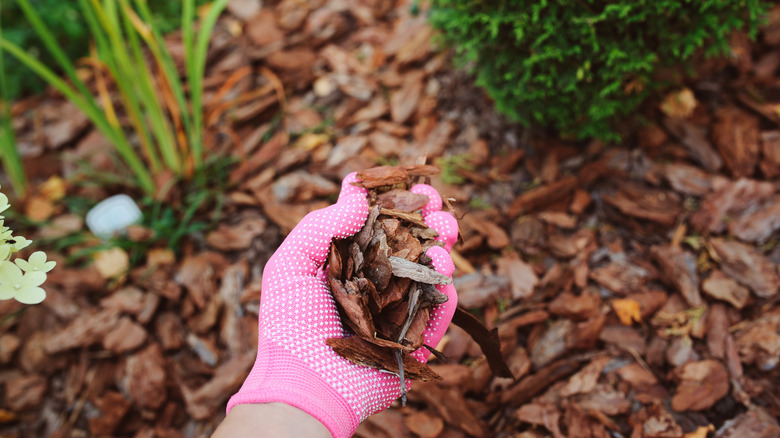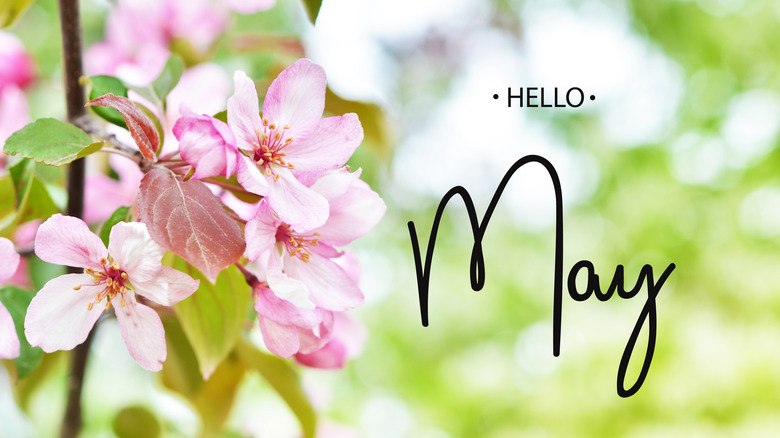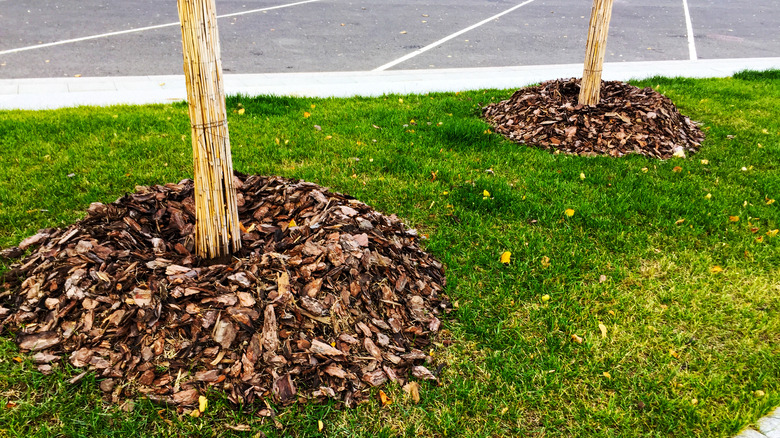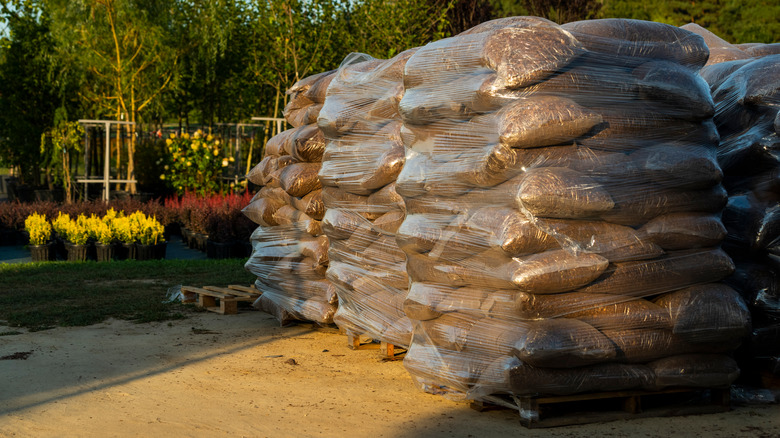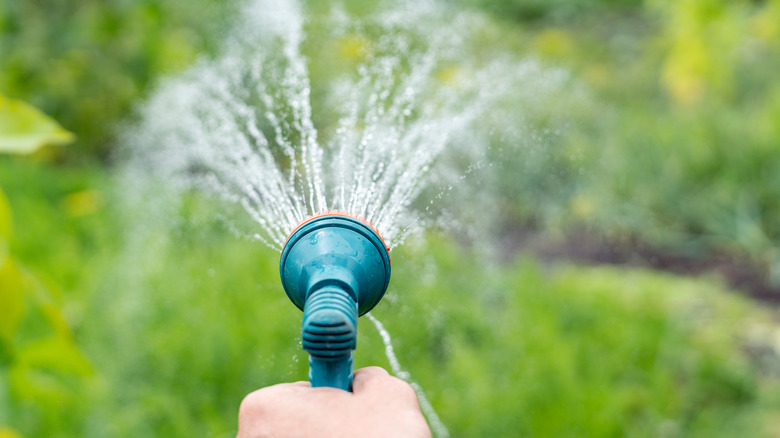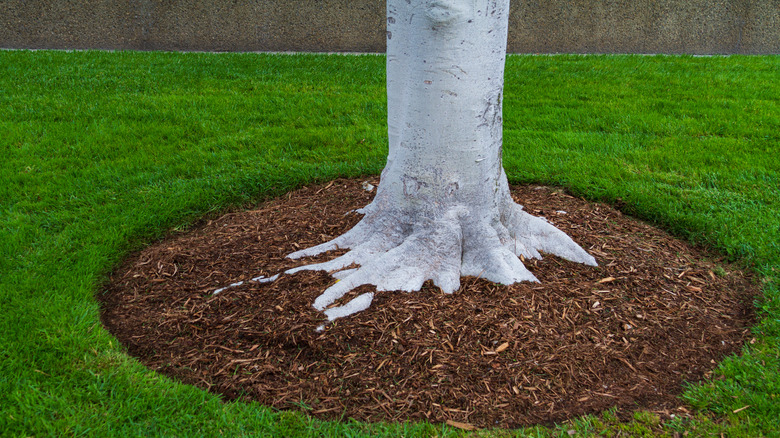Common Mulching Mistakes You're Making In Your Garden
Mulch, mulch, mulch. We've read so many times that it's the key to growing a healthy garden that some of us may find ourselves in line at the garden center before the doors even open on the first day of spring. A word that comes from the German for "easy to decay," mulch has been on the radar of attentive landscapers and home gardeners since the 1930s, according to a 2020 study published by the Bulletin of the National Research Centre, and for good reason; an application of mulch has the potential to reduce the growth of weeds around our plants while also conserving moisture and regulating the temperature of the soil below it.
On some levels, mulching to fix all of our botanical problems seems a little too good to be true. Yet, for the most part, it truly is a beneficial practice, provided we steer clear of the biggest gardening mistakes we all tend to make at some point.
Wrong time of year
Soil needs to start warming up as nature intended before we impatient humans interfere with anything. Ohio State University Extension explains that applying mulch while it's still very chilly outside will have a negative effect on new plant growth. By insulating the cold ground, the mulch will prevent it from thawing, thus inhibiting development. Additionally, applying mulch to wet soil after a heavy rain is a definite no-no. This will likely cause the soil to become waterlogged, which will only increase the number of problems occurring. Lowe's adds that you want to give seedlings a chance to establish themselves before covering them up. For these reasons, the middle of spring to late spring is the ideal time for your first layer of mulch.
There are good reasons to add another thin layer of mulch as summer temperatures start to soar and you're looking to protect the ground, but later in the summer season is a different story. McCarty Mulch & Stone advises that, by that point, temperatures will generally start cooling off and you're unlikely to get much bang for your buck. It's simply not worth the trouble or the money. If you're looking to regulate soil temperatures for winter, you can wait until late fall.
Too much mulch
It's easy to go overboard with mulch. If you've got extra in the bag, why not toss it on the pile, right? Actually, wrong. Spreading too much mulch is a mistake that causes more problems than it fixes. University of Maryland Extension explains that suffocation and rotting are the biggest concerns. First, a too-thick layer of mulch doesn't allow enough oxygen to get to the roots. This can cause them to shoot up into the mulch searching for air and, when the mulch inevitably dries out, they'll die. Second, the mulch holds in so much water that the trunks and stems stay wet and start to decay. A 3-inch-thick layer is plenty. Then wipe it away to clear a 3-inch circumference around the base of each plant.
That too-thick layer of mulch also creates a desirable environment for voles. While that may sound great to the vole family in the market for luxury digs, it spells disaster otherwise. The rodents' favorite snack: the trunks and stems of your precious perennials. Furthermore, too much of the good stuff will go beyond beneficial temperature regulation and into the zone of too warm or too cold, which in turn, will affect a plant's ability to begin or end a period of dormancy.
Worse than just a thick layer is the dreaded heaping mulch volcano seen in the photo above. Per Ohio State University Extension, avoid this technique at all costs as it's sure to cause lasting ill effects.
Wrong type of mulch
When you hit the store looking for mulch, be ready for a slew of options. Gardening Solutions from the University of Florida lists nine different types, which run the gamut from wood and bark chips to pebbles and rubber. Deciding on the best mulch for your garden comes down to what you want your garden to look like, how much you can or want to spend, and the durability and nutrient content of the products you're considering.
Organic mulches release nutrients in the soil but they decompose as the season goes on, causing you to refill areas that become bare. This would be the wrong choice for anyone lacking the time or ability to maintain their landscaping on a regular basis. For example, the University of Florida mentions grass clippings and fallen leaves as the ultimate in eco-friendly (and free!) design. They're high in nutritional value but they decompose the fastest and need to be constantly raked and tended.
On the other hand, inorganic materials offer nothing in terms of soil conditioning, but rocks and rubber also don't break down. In getting the benefit of never having to replace it, you have to keep in mind that the soil beneath this type of mulch needs to be in tip-top shape for feeding your plants. For those who have nutrient-deficient soil or live in particularly harsh places in terms of weather and environmental conditions, this is probably not the way to go.
Overwatering mulch
We love the fact that mulch retains moisture and our gardens and landscapes reap the rewards of never experiencing drought. Yet, as previously mentioned, too much of a good thing can go unexpectedly sideways and that certainly holds true for water.
In a 2013 interview with the Institute of Agriculture and Natural Resources at the University of Nebraska-Lincoln, extension educator Kelly Feehan said, "Plants do not grow well in a saturated or continuously wet soil. Overwatering is a waste of water and it is harmful to plants." It's a double whammy of waste leading to decay. She adds that it's important to mind your irrigation system rather than setting it to a consistent schedule and walking away assuming all is well.
Monitoring moisture levels can be as simple as sticking your thumb into the soil and seeing what sticks, or as detailed as consulting real-time rainfall data and digital gauges, explains AcuRite, a manufacturer of weather sensors and smart home devices. For many, a basic moisture meter purchased at a garden center will be enough to create an eye-opening and educational experience regarding just how wet the soil around the roots of your plants is staying. Conditions may look dry at the surface but if you continue to irrigate saturated roots, you risk overwatering your plants and causing (sometimes) irreversible damage.
Mulching the wrong plants
There are a few types of outdoor plants that will not respond well to mulch. Chief among them are the self-seeding flowers we wish to see return year after year. Horticulture Magazine points out that mulch cracks down on the seeds we want to encourage just as it does the weeds we don't. This makes perfect sense, but in our desire to rid our gardens of ugly weeds, we might not even think about the self-seeders. Instead of allowing them to effortlessly cover our backyards in color and delight, we end up inadvertently snuffing them out.
Horticulture Magazine advises collecting fallen leaves or pine needles to create a thin layer of organic mulch that will aid in weed suppression while allowing seedlings to grow. Another option is to wait until the seedlings sprout up before applying any sort of ground cover. Of course, this means either an education in plant identification so you don't mistake your self-seeding flower shoots for weeds, or just dealing with a few weeds until you can tell the difference.
Conversely, there are large plants that would benefit from mulch yet often get overlooked as we tend to our walkways hoping to boost curb appeal. Per Penn State Extension, landscape trees in the middle of your yard or near the street will appreciate the ability of mulch to mimic the soil environment of a forest.
